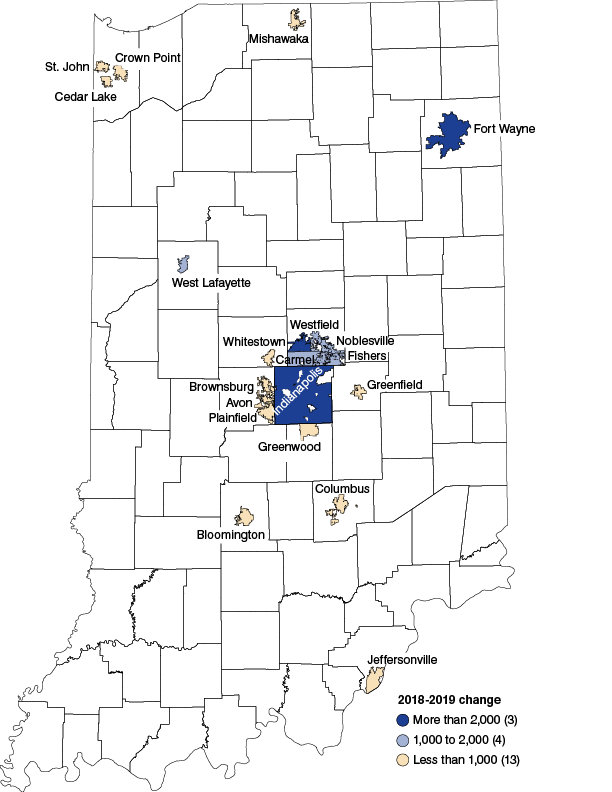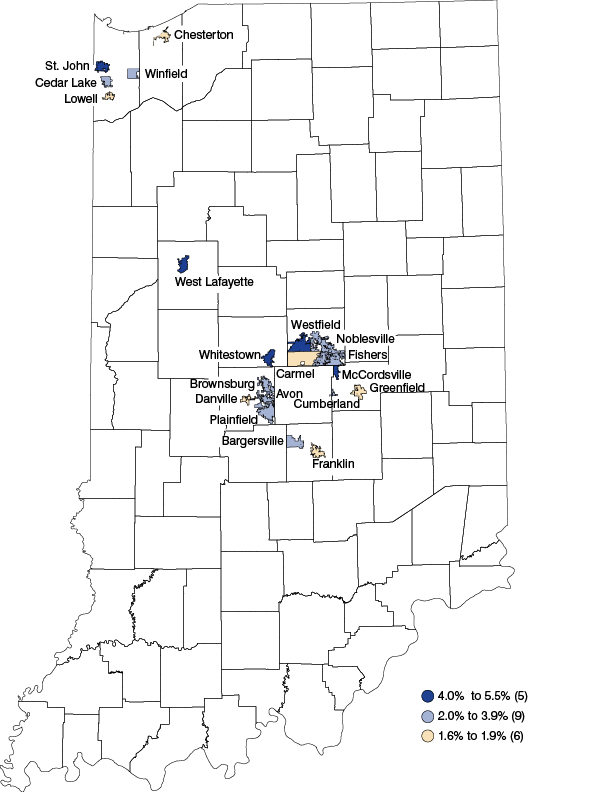Central Indiana communities drive population growth in the state

Indianapolis and its suburbs claimed seven of the state's 10 largest population increases in 2019.
In 2019, seven Indiana cities posted an annual population gain greater than 1,000 residents, according to U.S. Census Bureau estimates. Indianapolis tops the list by adding 5,424 people last year, which brings the nation’s 17th largest city to a total population of 876,384.
Four locales in neighboring Hamilton County also rank among these top gainers, led by Westfield’s addition of 2,137 residents in 2019 and followed by Carmel (1,925), Fishers (1,903) and Noblesville (1,365). In all, cities and towns in the Indianapolis metro area claimed seven of the state’s 10 largest increases last year.
The following interactive graphic provides details on population change since 2010 for each of Indiana’s 567 incorporated places (see Figure 1).
Figure 1: Explore Indiana city/town population change
Source: IBRC, using U.S. Census Bureau data
Outside of Central Indiana, Fort Wayne (adding 2,942 residents), West Lafayette (1,977), St. John (806), Jeffersonville (683) and Bloomington (616) can also boast of large gains in 2019 (see Figure 2).
Figure 2: Cities with largest population growth, 2018 to 2019

Source: IBRC, using U.S. Census Bureau data
In terms of the pace of growth, Whitestown in Boone County, McCordsville in Hancock County and Westfield rank as Indiana's fastest-growing places among those with a population of at least 5,000 residents. These Indianapolis-area suburbs each grew by more than 5% in 2019.
For Whitestown, this marks the eighth time in the past nine years that it can claim the title of the state's fastest-growing place. Its population has nearly tripled over this span, from 3,141 in 2010 to 9,092 in 2019.
Other fast-growing communities include Lake County’s St. John (4.5% growth in 2019), West Lafayette (4.0%) and the Johnson County town of Bargersville (3.9%). In all, 19 of the state’s 20 fastest-growing cities and towns are found in either the Indianapolis metro area or the Indiana portion of the Chicago metro area (see Figure 3).
Figure 3: Indiana’s fastest-growing cities and towns, 2018 to 2019

Note: Growth rate rankings limited to cities and towns with at least 5,000 residents.
Source: IBRC, using U.S. Census Bureau data
Indiana’s largest cities
Indiana added a fifth member to its group of cities with a population of at least 100,000 residents in 2019. Carmel’s growth of more than 1,900 residents last year pushed its total population to 101,068, which ranks just behind South Bend (population 102,026). Given the recent growth trends for these two cities, Carmel will likely overtake South Bend in terms of total population in the next year.
With a population of 270,402, Fort Wayne remains Indiana’s second-largest city, and ranks 77th-largest nationwide. Evansville places third on the list of the state’s most populous cities, but with an estimated loss of 81 residents in 2019, it is Indiana’s largest city to show a population decline last year.
As Table 1 shows, the remainder of Indiana's 10 largest cities are Fishers (95,310), Bloomington (85,755), Hammond (75,522), Gary (74,879) and Lafayette (71,721).
Table 1: Indiana’s 10 largest cities, 2019
| City | Total population, 2019 | Change, 2018-2019 | Percent change |
|---|---|---|---|
| Indianapolis | 876,384 | 5,424 | 0.6% |
| Fort Wayne | 270,402 | 2,942 | 1.1% |
| Evansville | 117,979 | -81 | -0.1% |
| South Bend | 102,026 | 55 | 0.1% |
| Carmel | 101,068 | 1,925 | 1.9% |
| Fishers | 95,310 | 1,903 | 2.0% |
| Bloomington | 85,755 | 616 | 0.7% |
| Hammond | 75,522 | -355 | -0.5% |
| Gary | 74,879 | -331 | -0.4% |
| Lafayette | 71,721 | -512 | -0.7% |
Source: U.S. Census Bureau
Twelve of Indiana's 20 largest cities posted a population gain in 2019. Among the cities that lost population, Lafayette had the largest decline, losing an estimated 512 residents. Other cities with relatively large drops include Hammond (decline of 355 residents), Gary (down 331) and Terre Haute (down 153).
Town and country
Looking at differences between urban and rural communities, the data show that most Hoosiers live in cities or towns. Nearly 36% of the state's population lived in a city with a population of at least 50,000 in 2019. Meanwhile, 19% of Hoosiers lived in an incorporated place of between 10,000 and 50,000 residents, while another 12% lived in a city or town with fewer than 10,000 residents (see Table 2).
Table 2: Indiana population by type of community, 2019
| Community type | Total population | Percent of Indiana population | Percent change, 2018 to 2019 |
|---|---|---|---|
| City/town, population 50,000+ | 2,390,295 | 35.5% | 0.7% |
| City/town, population 10,000-49,999 | 1,281,084 | 19.0% | 0.8% |
| City/town, population < 10,000 | 834,295 | 12.4% | 0.4% |
| Unincorporated areas | 2,226,545 | 33.1% | 0.3% |
Source: IBRC, using U.S. Census Bureau data
In all, two-thirds of Indiana's 6.7 million residents in 2019 lived in incorporated places, while the remaining 2.2 million Hoosiers lived in unincorporated areas of the state. Indiana's cities and towns as a group accounted for 79% of the state's total population growth in 2019.
For more estimates data, visit STATS Indiana's population topic page.
